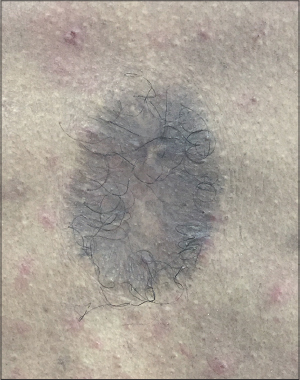Hypertrichosis on the periphery of the scar of a thermal burn
Khalid Al Aboud 1, Daifullah Al Aboud2, Ahmad Al Aboud3
1, Daifullah Al Aboud2, Ahmad Al Aboud3
1Dermatology Department, King Faisal Hospital, Makkah, Saudi Arabia, 2Dermatology Department, Taif University, Taif, Saudi Arabia, 3Dermatology Department, King Abdullah Medical City, Makkah, Saudi Arabia
Corresponding author: Khalid Al Aboud, MD
How to cite this article: Al Aboud K, Al Aboud D, Al Aboud A. Hypertrichosis on the periphery of the scar of a thermal burn. Our Dermatol Online. 2021;12(3):335-336.
Submission: 29.11.2020; Acceptance: 06.03.2021
DOI: 10.7241/ourd.20213.27
Citation tools:
Copyright information
© Our Dermatology Online 2021. No commercial re-use. See rights and permissions. Published by Our Dermatology Online.
Sir,
The term hypertrichosis refers to the growth of hair that is considered excessive for the site and the patient’s age [1]. It is classified into localized or generalized, both either congenital or acquired [2]. Herein, we report a case of localized hypertrichosis.
A 35-year-old Ethiopian male presented himself with chickenpox and was found to have excessive coarse hair on the periphery of an old scar that resulted from a thermal burn in childhood (Fig. 1).
 |
Figure 1: Hypertrichosis on the periphery of the scar of a burn on the chest. |
The patient’s family used to employ cautery as a traditional method of therapy for disease but he was incognizant of the reason for the cautery in his case.
He noticed the increased growth of hair around the scar a long time ago and failed to recall its first appearance. No hypertrichosis was found on the rest of the body. He had no history of medical issues and had not taken any medications before.
Box 1 lists selected causes, including conditions, associated with localized hypertrichosis [1–7], some only temporary and not persistent.
 |
Box 1: Selected causes, including conditions, associated with localized hypertrichosis [1–7] |
Several mechanisms have been proposed to explain the hypertrichosis in some of these conditions. For instance, a local increase in blood flow around the site of a fracture and the increased metabolism of the local soft tissues were thought to be the probable reason for the localized increase in hair growth after cast application [1].
Cases of hypertrichosis in relation to burns have been reported as early as 1965 in the indexed medical literature [7].
Shafir and Tsur reported a female who suffered a deep second-degree burn on the lateral aspect of the left thigh. She was hospitalized for one month after the accident due to the infection of the deep second-degree wound [4]. Meanwhile, the patient noticed that hair started growing on the periphery of the burned area. The area healed gradually and, on a follow-up six months later, it had remained hairy. The authors proposed that a burn may be regarded as a source of irritation, giving rise to localized hypertrichosis [4].
We believe that this phenomenon is not especially rare but it is reported less frequently as it is of lesser concern to the patient. We agree, however, that the question as to why some develop reactive hypertrichosis and most do not remains unanswered [4].
Consent
The examination of the patient was conducted according to the principles of the Declaration of Helsinki.
The authors certify that they have obtained all appropriate patient consent forms, in which the patients gave their consent for images and other clinical information to be included in the journal. The patients understand that their names and initials will not be published and due effort will be made to conceal their identity, but that anonymity cannot be guaranteed.
REFERENCES
1. Tamer F, Yuksel ME. Giant congenital melanocytic nevus coexisting with an asymmetric posture. Our Dermatol Online. 2017;9:68-70.
2. Valia RG. Hypertrichosis. Indian J Dermatol. 2005;50:119-24.
3. Chaoui R, Baybay H, El Kadiri S, Achehboune K, Douhi Z, Elloudi S, et al. Giant congenital melanocytic nevus associated with lipoma. Our Dermatol Online. 2020;11(e):e7.1-e7.3.
4. Chaouche M, Barbach Y, Cherif AD, Elloudi S, Baybay H, Mernissi FZ. Vascular tumor and hypertrichosis as skin markers of occult spinal dysraphism. Our Dermatol Online. 2019;10(e):e10.1.
5. Uslu A, SürücüA, Korkmaz MA, Uygur F. Acquired localized hypertrichosis following pressure garment and/or silicone therapy in burn patients. Ann Plast Surg. 2019;82:158-61.
6. Honda T, Koreeda S, Miyachi Y, Kabashima K. Hypertrichosis around a leg ulcer being treated with prostaglandin E1 ointment. J Am Acad Dermatol. 2011;64:1212-3.
7. Martini L. A biological melange and a peculiar led light could be a thaumaturgic approach to defeat manifold types of folliculitis in man and woman. Our Dermatol Online. 2017;8:27-30.
Notes
Source of Support: Nil,
Conflict of Interest: None declared.
Request permissions
If you wish to reuse any or all of this article please use the e-mail (brzezoo77@yahoo.com) to contact with publisher.
| Related Articles | Search Authors in |
|
|



Comments are closed.